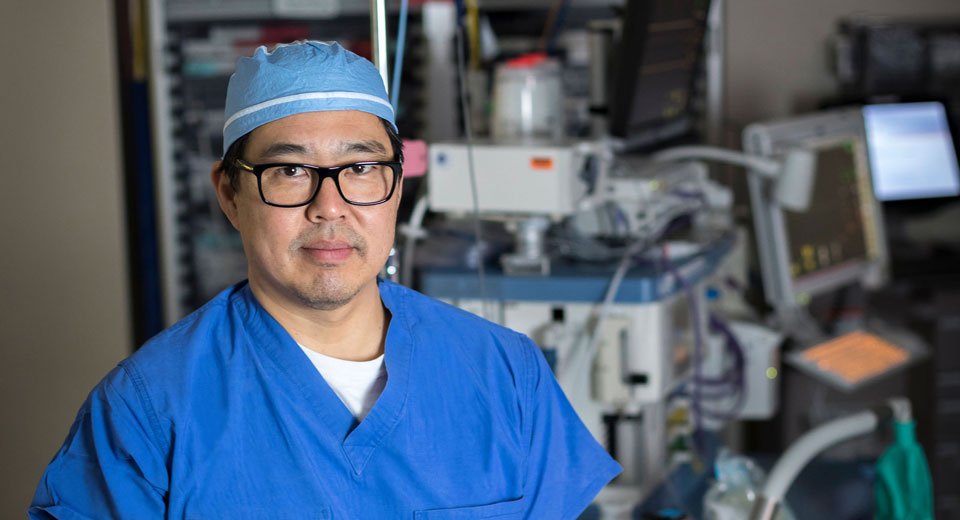A better view of the spine
Each year, more than 400,000 Americans with aching backs undergo the surgical procedure known as spinal fusion. Often performed in tandem with other forms of back surgery, spinal fusion helps to ease pain and restore stability to the spine.
Cape Cod Hospital is one of the few medical centers in Massachusetts where neurological surgeons are able to perform this important operation in a way that’s faster and safer for patients, thanks to advanced technology known as the O-Arm Imaging System.
“The O-arm has really revolutionized the way we do spinal fusions,” said Achilles Papavasiliou, MD, FAANS, a neurological surgeon at Cape Cod Hospital. Dr. Papavasiliou and his colleagues at Cape Cod Healthcare Neurosurgery in Hyannis have used the O-arm to perform several thousand spinal fusions and other procedures, and say the remarkably detailed, real-time images it provides during an operation allow them to work with greater precision and efficiency.
Spinal fusion is often compared to welding, but the procedure involves some carpentry, too. The procedure is commonly performed in tandem with a variety of other spinal surgeries, such as discectomy, in which a surgeon removes a herniated (or bulging) disc - the shock-absorbing cushion between two spinal bones (or vertebrae) - that’s compressing nerves and causing pain. In most cases, the next step is to fuse the two vertebrae together into one bone by filling the now-empty disc space with a bone graft, which is usually obtained from a donor cadaver. Over time, the graft will help the two vertebrae grow together as one. To keep the spine in position while the bones bond, the surgeon inserts tiny screws and rods to align and stabilize the two vertebrae.
Multiple X-rays
Another common spinal condition that is frequently treated with spinal fusion is spondylolisthesis, which can occur when joints in the spine become arthritic and allow a vertebra to shift out of place, irritating nerves. In traditional spinal fusion surgery, surgeons rely on X-rays to position screws and rods, which can be cumbersome and slow, said Gordon Nakata, MD, FAANS, a Cape Cod Hospital neurological surgeon.
“You have to rely on multiple, repeated snapshots” of the spine, he said. “You drill, take an X-ray, drill a little more, take an X-ray.”
Moreover, because X-rays produce only a flat, two-dimensional image, surgeons have to lean heavily on their understanding of the human body when placing the hardware used to stabilize the spine.
“We would make our best anatomic guess as to where screws should go,” said Dr. Papavasiliou. “O-arm takes the guesswork out.”
What It Does
The O-arm is a large circular device that stands roughly 6.5 feet high and is attached to a wheeled cart about the size of a washing machine. After the patient is in position on the operating table, one segment of the ring is opened, causing the O-arm to now resemble the letter C. The open end of the C is slid over and under the operating table, then closed to form a ring around the patient. The O-arm now scans the patient, taking nearly 400 high-definition images in just 13 seconds. These images are used to create two- and three-dimensional reconstructions of the segment of the patient’s spine that the surgeons are treating.
The images that the O-arm acquires are synchronized with a surgical navigation system that acts much like the global-positioning system (GPS) in your car or on your smartphone. As a result, surgeons can watch the movement of their instruments on a 30-inch TV monitor as they attach hardware to the vertebrae.
“We can see on the computer screen exactly where the screw is,” said Dr. Papavasiliou. In fact, the images produced by the O-arm are accurate to within one millimeter (or about 0.04 inch).
That precision has a major payoff. Dr. Nakata estimates that perhaps one percent to two percent of patients who undergo spinal fusion with traditional imaging end up needing a second trip to the operating room to have the position of their hardware adjusted. But among patients whose spinal fusions are performed with the O-arm, “the number is negligible,” he said.
Not only is accuracy of hardware placement superior, but at the end of every procedure, surgeons use the O-arm to perform another scan to confirm that the screws and rods are positioned properly.
What’s more, the O-arm has made spinal-fusion surgery safer, doctors say. For starters, noted Dr. Nakata, “the procedure is faster, and we know that complication risk is tied to the duration of surgery.” In other words, speedier procedures mean less blood loss, a lower risk for infection and less need for anesthesia. The latter is especially good news for elderly patients, who are at higher risk for complications related to anesthesia.
